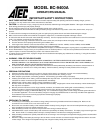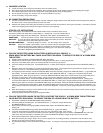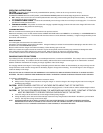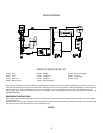4
OPERATING INSTRUCTIONS
CAUTION - This battery charger must be fully assembled before operating. Failure to do so may result in risk of injury.
USE OF INSTRUMENT PANEL:
The MINUTES CHARGE timer has an OFF position, a CONTINUOUS CHARGE position and a timed charge range from 0 to 90 minutes.
a. OFF - Always make sure the timer is in the OFF position before connecting or disconnecting the clamps from the battery. The charger will
not charge with the timer in this position.
b. 0 to 90 MINUTES TIMED CHARGE - The timer will automatically turn the charger off at the end of the pre-set charging time. Turn the timer
past 20 before setting the desired time.
c. CONTINUOUS CHARGE - This position is used for slow charging or parallel charging, the timer will not shut the charger OFF while in this
position. Do not use this position for fast charging.
TO CHARGE BATTERIES
Make the connections to the battery per the instructions in the previous sections.
Determine if the battery is 6 or 12 volts and then set the CHARGE VOLTAGE switch to 6 CHARGE for a 6 volt battery or 12 CHARGE/BOOST for
a 12 volt battery. Turn the timer on. The Ammeter will show the amount of current delivered to the battery. Length of charge should be per the
above chart and instructions.
BOOST STARTING
Turn off all lights and accessories in the stalled vehicle.
Connect the charger to battery per previous instructions. Charge the battery for at least five minutes before attempting to start the vehicle. Put
the switch in the 12 CHARGE/BOOST position.
Start the vehicle with the charger connected to the battery. Follow the duty cycle on the unit.
NOTE: Do not crank the engine more than 20 seconds in any five minute period; excessive cranking may overheat and damage the starter.
If the vehicle fails to start, while waiting for the starter to cool, allow the charger to continue to charge the battery.
Turn the switch to OFF and remove the AC power cord from the electric outlet before disconnecting the DC clamps.
CHARGING SULFATED BATTERIES
If your battery has sat in the discharged state for an extended period of time, it can become SULFATED. This usually is seen as a white deposit
near the top of the battery. The sulfate is formed when a battery with low water levels remains discharged for an extended time. Sulfated
batteries exhibit the characteristic of accepting no charge regardless of the rate of charge.
The charging method is two staged. The first stage of attempting to break down the sulfation to allow the battery to accept a charge must be
closely watched to avoid excessive charge rates as the battery begins to charge and overheating. The second stage is a slow charging to
restore the battery to full charge.
READ AND FOLLOW ALL PRECAUTIONS AND WARNINGS IN YOUR INSTRUCTION MANUAL BEFORE ATTEMPTING TO CHARGE SULFATED
BATTERIES. FAILURE TO OBSERVE THESE WARNINGS MAY RESULT IN PROPERTY DAMAGE OR SERIOUS PERSONAL INJURY OR DEATH.
To recharge a sulfated battery:
1. Attach the battery clamps as described in the instruction manual.
2. Always use the chargers lowest rate when turning the charger on. Set the charger to the chargers highest rate for the voltage of
the battery being charged.
CAUTION: NEVER CHARGE A BATTERY AT VOLTAGES RATES ABOVE THAT OF THE BATTERY.
3. The battery will show little or no amperage at the start of the charging process. This will continue until the sulfation begins to break
down.
CAUTION: AS THE SULFATION BREAKS DOWN, THE AMPERAGE MAY RAPIDLY RISE. CONSTANT ATTENTION
MUST BE OBSERVED TO PREVENT SERIOUS OVERHEATING OF THE BATTERY.
4. Lower the charge rate to the lowest rate for the voltage of battery being charged.
5. Charge the battery at this low rate until the electrolyte reaches the fully charged state as described in the tables in your instruction
manual. This may take as long as two or three days.
NOTE: SOME BATTERIES MAY BE SO BADLY SULFATED THEY CAN NOT BE RESTORED TO A NORMAL OPERATING CONDITION,
REGARDLESS OF THE RATE OF CHARGE OR THE LENGTH OF TIME THE CHARGE IS APPLIED. IF THE BATTERY CANNOT BE
RESTORED TO A FULLY CHARGED CONDITION BY A SLOW CHARGING, IT SHOULD BE REPLACED.









